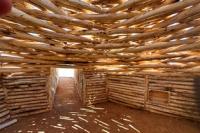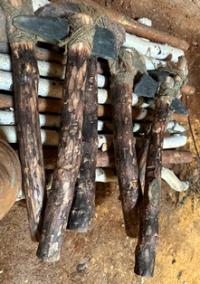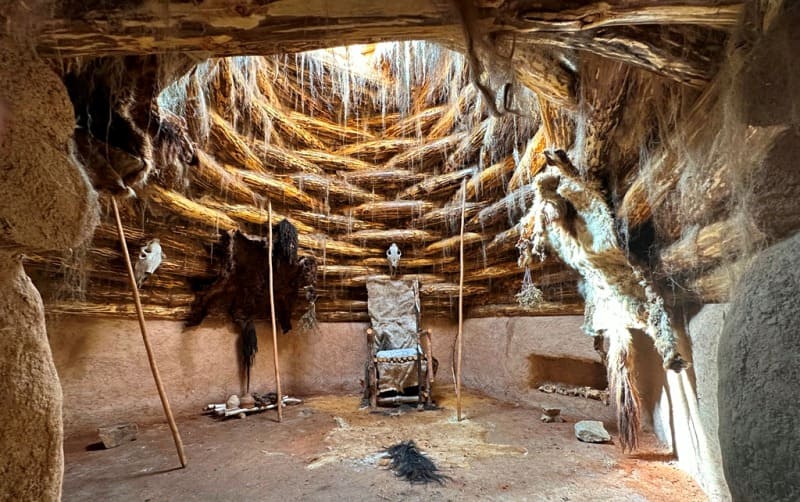Вы здесь
Вotai ancient settlement.



Ancient settlements Northern-Kazakh of region.
«Memory is the treasure house of the mind wherein the monuments thereof are kept and preserved»
Thomas Fuller.
Kazakhstan and New Silk Road.
Botai settlement is located at an altitude of 242 meters above sea level, located 40 meters and 240 meters from the right bank of the Iman-Burluk River, 2.4 kilometers southeast of the village of Nikolskoye-Burlukskoye, 10.4 kilometers northwest from the village of Kirillovka, 9.9 kilometers southeast of the village of Nikolskoye in the Aiyrtau district in the central part of the North Kazakhstan region.
The site of finds of artifacts of the Botai culture is located at an altitude of 240 meters above sea level, located 1.8 kilometers southeast of the village of Nikolskoye, 6.7 kilometers to the west and slightly north of the village of Nikolskoye-Burlukskoye, 11.9 kilometers to southwest of the village of Botai in the Aiyrtau district in the central part of the North Kazakhstan region.
The archaeological site of Botai was opened in 1980. The area of the settlement is 15 hectares. Archaeologists were immediately interested in a large number of depressions left after the destroyed dwellings. Excavations at the settlement exceeded the wildest expectations of archaeologists.
During the period of its existence, at least 250 dwellings were built in the settlement. Scientists managed to reconstruct the entire process of building dwellings by ancient builders. First, they dug a pit of a polygonal or rounded shape.
The depth of the pits is 60 - 80 cm, the area is from 30 to 70 square meters. Then they soaked the clay and laid it in lumps in the walls, which were strengthened from the inside and outside with the bones of animals.
The width of the walls of ancient dwellings was 80 - 120 cm, height - from 60 to 100 cm. Special pits were dug near the dwellings, from which clay was taken to cover the walls and floor. Along the perimeter of the walls, a hipped ceiling was erected from logs with a hole in the center for smoke.
The gaps between the logs were covered with clay, and covered with turf and animal skins on top. Thus, the height inside the building was 250 - 320 cm. The bulk of the work was related to security excavations in the southern and eastern parts of the site. In addition to security excavations, partial backfilling of small ravines was carried out in the northeastern part of the settlement at the source of a large ravine, where new small ravines are provoked annually in spring.
Thus, the entire coastline of the settlement was subjected to security excavations. The total area of the excavation was 592 square meters. In just the last three years of research, a significant amount of archaeological and security work has been carried out.
In total, 1756 square meters of the cultural layer were uncovered, more than 20,000 finds were made. In 1980, Viktor Seibert sent two young laboratory assistants to the steep bank of the Iman-Burluk River. They returned to the mentor with a cap full of fragments of ceramics and flint products.
Already a week after the start of the excavations, more than 40,000 artifacts were collected. And over the years of work, more than 200,000 of them have accumulated. Archaeologists were immediately interested in a large number of depressions left after the destroyed dwellings.
Excavations at the settlement exceeded the wildest expectations of archaeologists. During the period of its existence, at least 250 dwellings were built in the settlement. Scientists managed to reconstruct the entire process of building dwellings by ancient builders.
First, they dug a pit of a polygonal or rounded shape. The depth of the pits is 60 - 80 cm, the area is from 30 to 70 square meters. Then they soaked the clay and laid it in lumps in the walls, which were strengthened from the inside and outside with the bones of animals.
The width of the walls of ancient dwellings was 80 - 120 cm, height - from 60 to 100 cm. Special pits were dug near the dwellings, from which clay was taken to plaster the walls and floor. Along the perimeter of the walls, a hipped ceiling was erected from logs with a hole in the center for smoke.
The gaps between the logs were covered with clay, and covered with turf and animal skins on top. Thus, the height inside the room was 250 - 320 cm. The reconstruction was verified by experiment. In the summer of 1983, a dwelling of an ancient Botai was built over the foundation pit of an ancient dwelling.
The reconstruction paid off completely. In summer, the experimental dwelling was cool and dry. In the autumn-winter period, temperature drops were not observed in it. Consequently, with the constant observance of the basic requirements for the care of the dwelling (timely snow removal, removal of flood waters), it served a person as long as it withstood the overlap (on average, 15-20 years). Naturally, every year it was necessary to grease the walls, floors, the inside of the pit.
As it turned out during the excavations, in ancient times the living quarters of the Botai often closely adjoined each other. The following can be said about the interior layout of dwellings. There was a hearth in the center on the floor.
As a rule, there were small utility pits around the walls. Numerous niches were made in the walls of the pits for household and religious needs. The Botai slept on mats, skins, or built low bunks along the wall opposite to the exit. Interesting are the "canned pits" in which meat was stored for a long time.
This was done as follows: they dug a hole up to 1 meter deep, into which they put parts of the horse carcass, then covered it with skins and clay. A fire was lit from above, burning until all the oxygen burned out. After cooking, the meat could stay there for a long time without access to air.
Trial pits showed that capital buildings were erected on the territory. Later, in the north of Kazakhstan, several more similar settlements were discovered, 100-150 kilometers apart from each other (the optimal distance for grazing herds of horses).
ll this made it possible to talk about the Botai culture and the Botai people, who lived in the era of transition from stone to bronze, matriarchy to patriarchy, and made a real revolution, being the first to saddle a horse.
Koumiss was drunk six thousand years ago. The earliest known evidence of the domestication of horses was found on Botai. A group of archaeologists led by British scientists from the Universities of Exeter and Bristol recently wrote about this in the academic journal Science.
They noted that we are talking about the fourth millennium BC, which is about one thousand years earlier than all other evidence of the domestication of the horse and two thousand years older than those domesticated horses, the remains of which were found in Europe.
This conclusion was confirmed by the analysis of scrapings from pottery shards found on Botai, where traces of koumiss were found. It is quite clear: if a mare is milked, it means that she is no longer wild. Archaeologists believe that at that time about 10% of horses were domesticated, but free herds were also under human control.
This is how the technology of horse breeding in the steppes was born, which has survived to the present day. The core of the economic system of the Botai people was horse breeding, but in addition they were engaged in the processing of bone, wood, stone, and made ceramic dishes.
The inhabitants of the settlement had a device for drilling holes in stones and even a loom, which was tucked into hemp and nettle threads. On the bank of the river there were production facilities in which ancient people processed stone, wood, bones, animal skins, sewed clothes, and made ceramic vessels.
From stone, most often from flint, arrowheads, darts, spears, knives, scrapers were made. From the bones of a horse - chisels for processing wood, from the bones of birds - needles for sewing clothes. The food was meat, dairy, vegetable, fish. Scientists have determined this thanks to chemical analyzes made from vessels.
From the first day, scientists were surprised by the huge number of horse bones found during the excavations. Osteologists who study animal bones were invited to work. They have done a great job. About 133,000 horse bones were examined.
The result turned out to be very interesting: Botai's horses do not belong to any of the previously known types of horses. The bones of the Botai horse were different from the bones of other ancient horses. Scientists came to the conclusion that the Botai horse was domesticated.
These were not wild animals that grazed in the steppe. The horse was tamed and used by an ancient man for hunting, in the household. It was a real sensation! Until now, it was believed that the horse was domesticated much later.
Scientists from all over the world became interested in the materials of the settlement. To study the phenomenon of the Botai horse, scientists from Novosibirsk, Moscow, England, and Germany came to the North Kazakhstan region.
The opinion of many scientists is the same - the Botai settlement is the center of cattle breeding in the Eurasian steppes. Head of the North-Kazakhstan expedition Seibert V.F. was invited to England to the University of Cambridge to lecture on the Botai settlement.
Scientists have been studying Botai for many years. Dozens of articles have been written, books have been published. But there are still many mysteries that the Botai land keeps. It is still not clear how the ancient people buried their fellow tribesmen.
Several remains of an ancient man have been found, but they have given archaeologists new mysteries. They were in ruined dwellings. Of particular interest is one human skull. It is now in the exposition of the regional local history museum.
Two holes were made in the back of the skull, which were drilled into a person at the age of 14-16 years, and then the person lived for another 17 years. The drills are made in such a way that they do not affect the human brain.
But it was done with a stone knife. What is it, a surgical operation? Ancient man knew human anatomy so well that he was not afraid to perform the most difficult operation. Scientists suggest that it was not an ordinary person.
He belonged to people of a special category: shamans, priests, saints. Impact through these openings on the brain caused this man terrible pain, he began to delirious. Ancient people believed that he communicates with spirits or some forces of nature.
After death, a clay mask was made on the face of a person. He was buried at the entrance to the dwelling. Apparently, it was believed that he protects the well-being of the house. The Botai, who did not study at any medical academies and had only a primitive flint drill as a tool, were able to make two holes in the skull of a relative without hitting the brain at all, neurosurgeons called it fantastic!
It is noteworthy that the holes were open, for some reason the bone tissue was not allowed to overgrow. This was done, apparently, with the help of some kind of knuckle, which gave the person unbearable pain. Victor Seibert put forward his version.
“Anthropologists reported that it was impossible to determine the sex of a person who underwent trepanation, it could be a man, or it could be a woman,” says Viktor Fedorovich.
- "I think that a hermaphrodite was born on Botai, recognized as a special creature. He was practically deified. Most likely, he becomes a shaman, and the holes in his skull were made so that when the stick vibrates, touching the nerve receptors, it causes pain, foaming, a state of trance. This, apparently, was necessary for spiritual mysteries."
In the course of my acquaintance with the reports on the study of the skeletal remains of people, I was personally struck by the following fact: almost everyone had good teeth that did not undergo caries. This is because, says Viktor Fedorovich, that the Botai did not know sugar.
In general, their life cannot be called sweet, the conditions are very harsh. It is difficult to draw a general portrait of a Botai. The fact is that skulls of people of several races were found on the territory of the settlement: equatorial, Mediterranean, proto-Indo-European and Mongoloid.
All this speaks of the contact of people in these parts, mobility, susceptibility. This trend continued later, in the first millennium BC, according to anthropologists, the racial type of the steppe population was 70% Caucasoid and 30% Mongoloid (now these figures have reversed).
Perhaps this is where the phenomenon of Eurasianism comes from? Botai settlements existed for about six hundred years. After global warming, when the rich steppe grasses disappeared, a massive loss of horses began, most of the population went to the east, the Urals, Altai, where they assimilated.
“There used to be an opinion among historians that before the Bronze Age this land was only a transport corridor through which the Indo-Aryans, Europeans, Turks and others passed, but never settled for a long time,” says Professor Seibert.
– “Botai’s discovery made it possible to completely refute this. It became clear that a dynamic history, cultural genesis, a global adaptation of human groups in the environment, begins here. It was the Botais who formed the type of activity in which people can survive in the steppe, it was here that the steppe civilization was formed, which gave the ancient ecumene great discoveries.
Geographic coordinates of Botai settlement: N53°11'59.51" E67°39'21.98"
Geographical coordinates of place where Botai culture was found: N53°13'11.75" E67°32'00.91"







Authority:
Cultural heritage, Madeni Mura Elena Chernyshova. Text www.express-k.kz
http://opp.kz/forum
Photos by
Alexander Petrov.







